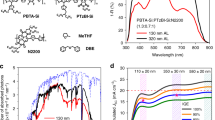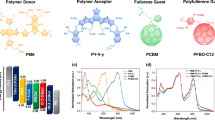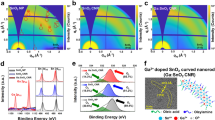Abstract
Inverted polymer bulk heterojunction solar cells have received a great deal of attention because of their compatibility with large-scale roll-to-roll processing. The inverted cell geometry has the following structure: substrate (rigid or flexible)/indium tin oxide/electron-transporting layer/photoactive layer/hole-transporting layer/top anode. Solution-processed metal-oxide films, based on materials such as ZnO and TiO2, are typically used as the electron-transporting layers. Here, we demonstrate enhanced charge collection in inverted polymer solar cells using a surface-modified ZnO–polymer nanocomposite electron-transporting layer. Using this approach, we demonstrate inverted polymer solar cells based on a low-bandgap polymer with an alternating dithienogermole–thienopyrrolodione repeat unit (PDTG–TPD) with certified power conversion efficiencies of 7.4%. To our knowledge, this is the highest efficiency reported to date for polymer solar cells with a device architecture compatible with the roll-to-roll process.
This is a preview of subscription content, access via your institution
Access options
Subscribe to this journal
Receive 12 print issues and online access
$209.00 per year
only $17.42 per issue
Buy this article
- Purchase on Springer Link
- Instant access to full article PDF
Prices may be subject to local taxes which are calculated during checkout





Similar content being viewed by others
References
Li, G., Chu, C. W., Shrotriya, V., Huang, J. & Yang, Y. Efficient inverted polymer solar cells. Appl. Phys. Lett. 88, 253503 (2006).
Chen, L. M., Hong, Z. R., Li, G. & Yang, Y. Recent progress in polymer solar cells: manipulation of polymer:fullerene morphology and the formation of efficient inverted polymer solar cells. Adv. Mater. 21, 1434–1449 (2009).
Peet, J. et al. Efficiency enhancement in low-bandgap polymer solar cells by processing with alkane dithiols. Nature Mater. 6, 497–500 (2007).
Chen, H-Y. et al. Polymer solar cells with enhanced open-circuit voltage and efficiency. Nature Photon. 3, 649–653 (2009).
Hou, J. et al. Synthesis of a low band gap polymer and its application in highly efficient polymer solar cells. J. Am. Chem. Soc. 131, 15586–15587 (2009).
Hou, J., Chen, H-Y., Zhang, S., Li, G. & Yang, Y. Synthesis, characterization, and photovoltaic properties of a low band gap polymer based on a silole-containing polythiophenes and 2,1,3-benzothiadiazole. J. Am. Chem. Soc. 130, 16144–16145 (2008).
Li, Z. et al. Alternating copolymers of cyclopenta[2,1-b;3,4-b′]diothiophene and thieno[3,4-c]pyrrole-4,6-dione for high performance polymer solar cells. Adv. Funct. Mater. 21, 3331–3336 (2011).
Park, S. H. et al. Bulk heterojunction solar cells with internal quantum efficiency approaching 100%. Nature Photon. 26, 297–303 (2009).
Yip, H-L., Hau, S. K., Baek, N. S., Ma, H. & Jen, A. K-Y. Polymer solar cells that use self-assembled-monolayer-modified ZnO/metals as cathodes. Adv. Mater. 20, 2376–2382 (2008).
Krebs, F. C. All solution roll-to-roll processed polymer solar cells free from indium-tin-oxide and vacuum coating steps. Org. Electron. 10, 761–768 (2009).
Krebs, F. C. Polymer solar cell modules prepared using roll-to-roll methods: knife-over-edge coating, slot-die coating and screen printing. Sol. Energy Mater. Sol. Cells 93, 465–475 (2009).
Krebs, F. C., Gevorgyan, S. A. & Alstrup, J. A roll-to-roll process to flexible polymer solar cells: model studies, manufacture and operational stability studies. J. Mater. Chem. 19, 5442–5451 (2009).
Krebs, F. C., Tromholt, T. & Jorgenson, M. Upscaling of polymer solar cell fabrication using full roll-to-roll processing. Nanoscale 2, 873–886 (2010).
Beek, W. J. E. et al. Hybrid zinc oxide polymer bulk heterojunction solar cells. J. Phys. Chem. B 109, 9505–9516 (2005).
Hau, S. K. et al. Air-stable inverted flexible polymer solar cells using zinc oxide nanoparticles as an electron selective layer. Appl. Phys. Lett. 92, 253301 (2008).
Guo, L. et al. Highly monodisperse polymer-capped ZnO nanoparticles: preparation and optical properties. Appl. Phys. Lett. 76, 2901–2903 (2000).
Mahamuni, S. et al. ZnO nanoparticles embedded in polymeric matrices. Nanostruct. Mater. 7, 659–666 (1996).
Cavaleri, J. J. et al. Femtosecond study of the size-dependent charge carrier dynamics in ZnO nanocluster solutions. Chem. Phys. 103, 5378–5386 (1995).
Sakohara, S. et al. Visible luminescence and surface properties of nanosized ZnO colliods prepared by hydrolyzing zinc acetate. J. Phys. Chem. B 102, 10169–10175 (1998).
Monticone, S. et al. Complex nature of the UV and visible fluorescence of colloidal ZnO nanoparticles. J. Phys. Chem. B 102, 2854–2862 (1998).
Guo, L. et al. Synthesis and characterization of poly(vinylpyrrolidone)-modified zinc oxide nanoparticles. Chem. Mater. 12, 2268–2274 (2000).
Du, T. B. & Ilegbusi, O. J. Synthesis and morphological characterization on PVP/ZnO nano hybrid films. J. Mater. Sci. Lett. 39, 6105–6109 (2004).
Du, T. B., Song, H. W. & Ilegbusi, O. J. Sol-gel derived ZnO/PVP nanocomposite thin film for superoxide radical sensor. Mater. Sci. Eng. C 27, 414–420 (2007).
Singla, M. L. et al. Optical characterization of ZnO nanoparticles capped with various surfactants. J. Lumin. 129, 434–438 (2009).
Tang, H. X. et al. Gas sensing behavior of polyvinylpyrrolidone-modified ZnO nanoparticles for trimethylamine. Sens. Actuat. B 113, 324–328 (2006).
Amb, C. M. et al. Dithienogermole as a fused electron donor in bulk heterojunection solar cells. J. Am. Chem. Soc. 133, 10062–10065 (2011).
Chu, T. Y. et al. Bulk heterojunction solar cells using thieno[3,4-c]pyrrole-4,6-dione and dithieno[3,2-b:2′, 3′-d]silole copolymer with a power conversion effciency of 7.3%. J. Am. Chem. Soc. 12, 4250–4253 (2011).
Subbiah, J., Kim, D. Y., Hartel, M. & So, F. MoO3/TFB double interlayer effect on polymer solar cells. Appl. Phys. Lett. 96, 063303 (2010).
Subbiah, J. et al. Combined effects of MoO3 interlayer and PC70BM on polymer photovoltaic device performance. Org. Elect. 11, 955–958 (2010).
Kim, D. Y. et al. The effect of molybdenum oxide on organic solar cells. Appl. Phys. Lett. 95, 093304 (2009).
Irfan et al. Energy level evolution of molybdenum trioxide interlayer between indium tin oxide and organic semiconductor. Appl. Phys. Lett. 96, 073304 (2010).
Meyer, J. et al. MoO3 films spin-coated from a nanoparticle suspension for efficient hole-injection in organic electronics. Adv. Mater. 23, 70–73 (2011).
Lilliedal, M. R. et al. The effect of post-processing treatments on inflection points in current–voltage curves of roll-to-roll processed polymer photovoltaics. Sol. Energy Mater. Sol. Cells 94, 2013–2031 (2010).
Aliaga, C. et al. Sum frequency generation and catalytic reaction studies of the removal of organic capping agents from Pt nanoparticles by UV-ozone treatment. J. Phys. Chem. C 113, 6150–6155 (2009).
Park, J. Y., Aliaga, C., Renzas, J. R., Lee, H. & Somorjai, G. A. The role of organic capping layers of platinum nanoparticles in catalytic activity of CO oxidation. Catal. Lett. 129, 1–6 (2009).
Sun, Y. M., Seo, J. H., Takacs, C. J., Seifter, J. & Heeger, A. J. Inverted polymer solar cells integrated with a low-temperature-annealed sol–gel-derived ZnO film as an electron transport layer. Adv. Mater. 23, 1679–1683 (2011).
Zhang, Y. T. et al. X-ray photoelectron spectroscopy study of ZnO films grown by metal-organic chemical vapor deposition. J. Crystal Growth 252, 180–183 (2003).
Acknowledgements
The authors acknowledge support from the Office of Naval Research (contract no. N000141110245) for the fabrication and characterization of polymer solar cells. F.S. acknowledges support from the Department of Energy Basic Energy Sciences (contract no. DE-FG0207ER46464) for the synthesis and characterization of ZnO composite films. J.R.R. acknowledges the support of the Air Force Office of Scientific Research (contract no. FA9550-09-1-0320) for the synthesis of the PDTG and PDTS polymers. The authors would also like to thank the Major Analytical Instrumentation Center (MAIC) and the Dr Andrew Rinzler research group at the University of Florida for their assistance in characterizing the ZnO composite films.
Author information
Authors and Affiliations
Contributions
C.E.S. performed polymer solar cell fabrication, characterization and data analysis, as well as characterization of the ZnO–polymer films by AFM and XPS. S.C. contributed to data analysis, establishing a model to explain the ETL effects, and fabrication of the certified solar cells. J.S. contributed to the early process optimization of the PDTG–TPD and PDTS–TPD BHJ solar cells. T-H.L. conceived the idea for modification of the ZnO–polymer composite ETL by UV-ozone treatment and conducted optical transmission measurements. C.A. synthesized the polymers used in this work. S-W.T. assisted in planning and interpreting the data. F.S. and J.R.R. initiated and directed the research project. All authors discussed the results and commented on the manuscript.
Corresponding authors
Ethics declarations
Competing interests
The authors declare no competing financial interests.
Supplementary information
Rights and permissions
About this article
Cite this article
Small, C., Chen, S., Subbiah, J. et al. High-efficiency inverted dithienogermole–thienopyrrolodione-based polymer solar cells. Nature Photon 6, 115–120 (2012). https://doi.org/10.1038/nphoton.2011.317
Received:
Accepted:
Published:
Issue Date:
DOI: https://doi.org/10.1038/nphoton.2011.317
This article is cited by
-
Tin-doped ZnO electron transport layer to improve performance of P3HT-based organic solar cells
Journal of Sol-Gel Science and Technology (2023)
-
Influence of corona poling on ZnO properties as n-type layer for optoelectronic devices
Scientific Reports (2022)
-
Block copolymers as efficient cathode interlayer materials for organic solar cells
Frontiers of Chemical Science and Engineering (2021)
-
Fast and feasible fabrication of zinc- and lithium-doped cobalt oxide layers as an emerging hole injection candidate for perovskite solar cells
Journal of Materials Science: Materials in Electronics (2021)
-
Functional nanocomposites and their potential applications: A review
Journal of Polymer Research (2021)



